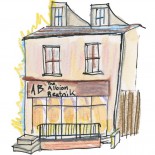The Albion Beatnik Bookstore website (or how to change a light bulb in a tight space on a ladder)
The web page of the Albion Beatnik Bookstore, based once in Oxford, then Sibiu, always neo-bankrupt, now closed for business: atavistic and very analogue, its musings and misspells on books and stuff.
Mary Webb’s Gone to Earth
 One of the books to be published later this year by the Albion Beatnik Press is Gone to Earth by Mary Webb. (The cover design is by Alexandra Andries.) This was Webb’s second novel, published in September 1917. She wrote it in response to the tragedy and destruction of the First World War.
One of the books to be published later this year by the Albion Beatnik Press is Gone to Earth by Mary Webb. (The cover design is by Alexandra Andries.) This was Webb’s second novel, published in September 1917. She wrote it in response to the tragedy and destruction of the First World War.
Mary Webb’s novels are usually set in her familiar Shropshire landscape. Her family descended from Walter Scott (though we shouldn’t hold that against her) and she had ambitions for her writing that were sadly never met in her lifetime, though in the year after her death Stanley Baldwin, when Prime Minister, referred to her as a “neglected genius” at a Literary Fund dinner. He had first read her over his Christmas break in 1926. Soon after he wrote to her from Downing Street, on 14th January, 1927. “I hope you will not think it an impertinence on my part if I tell you with what keen delight I have read Precious Bane.” Baldwin’s family had come from Shropshire, so there was an affinity. He went on to write, “I think it is a really first class piece of work and I have not enjoyed a book so much for years.” The Prime Minister’s public praise of her work stampeded interest in her books: a handsome Collected Edition followed (Baldwin wrote the Introduction to Precious Bane) and her books sold like hot cakes for the next decade.
Gone to Earth is the story of Hazel, a child of nature who loves wild animals and the weather and seasons of the countryside and wants simply to be herself. She is drawn reluctantly into the world of romantic human relationships through her great beauty, marrying a local church minister; she also becomes the object of the local fox hunting squire’s obsessive love. Hazel casts herself down a mineshaft to escape, clutching her beloved pet fox.
Stella Gibbons’ fabulous Cold Comfort Farm was a parody of Mary Webb’s writings, written in 1932, and of other “loam and lovechild” writers like Sheila Kaye Smith (whose novels were set in Sussex), Mary E. Mann (Norfolk) and, much earlier, Thomas Hardy. Mary Webb’s writing (literary critic John Sutherland referred to her style as “soil and gloom romance”) – where men’s stubble was as wild and verdant as the Shropshire valleys – is a little bit off the radar today. In literary terms, Stella Gibbons might be seen as the Gillette razor blade advert of her day.
Here are two photographs of the period. The first is Stanley Baldwin on the way to the dispatch box in the House of Commons, clutching the Albion Beatnik’s Press edition of Gone to Earth. The second is Stella Gibbons, who has received through the post a review copy. She has been rather critical: “I did not believe people were any more despairing in Herefordshire [?] than in Camden Town.” But she says it has given her an idea and she promises to write much more in response, possibly a novel.
Stella Gibbons criticised further. The “large agonised faces in Mary Webb’s book annoyed me.” They didn’t me, and here are four of the illustrations commissioned for the book from Prague-based artist Christopher Vinz.






